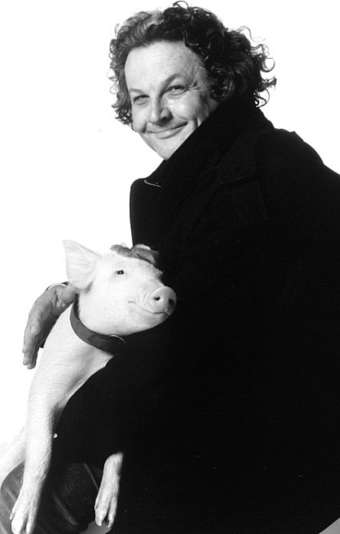
- Recurring Visual and Thematic Motifs, et. al.
(and, immediately from where we left off previously -)
Sven: Well, I think that it would not be a stretch to say that one of Miller's pet symbols is that of flight, if that can rightly be called a symbol. More a technique. But in the latter two Mad Max films, there's a flying character, there's aerial dynamics in Babe: Pig in the City with the bungee at the end, the witches of Eastwick fly sometimes, penguins are naturally flightless (although the camera in that is frequently soaring, sometimes into outer space), Lithgow is stuck on an airplane with a gremlin...
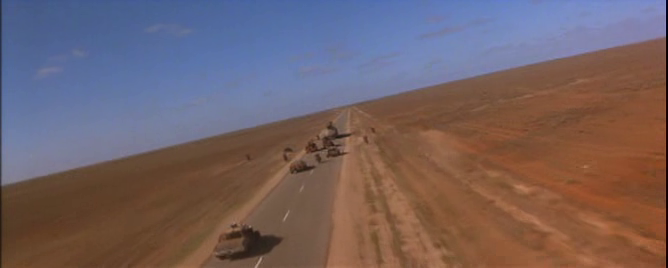
TheFilmist: Also in Babe: Pig In the City, those wide panoramic shots near the middle of the film with Ferdinand soaring over the animal control vans.
Sven: Ah yes. "Fair well, noble duck..." Love that line.
TheFilmist: In "The Road Warrior," and "Beyond Thunderdome," I think it has a more overt thematic relevance. Rob Ager, in one of his only sane pieces of film analysis, said of the Gyro Captain:
"The gyro captain provides a stark parallel throughout the story, by which Max’s wounds are laid bare for us to see. Emotionally maimed by the loss of his family, Max is unable to accept an invitation to join the camp and hence rejoin humanity, while the gyro captain leaps at the opportunity. The image of a naked woman pasted onto the rudder of the Captains flying machine shows that his fantasy of a female partner is still alive. Of the two most attractive females in the camp, gyro captain quickly snatches up a new mate, while Max walks away from a glaring opportunity for love - perhaps he was wise to do so (his admirer is viciously killed in the final battle scene). Gyro Captain is the most inspired man in the film and his flying machine enables him to be free of the hellish landscapes to wonder the open skies. In many ways he could even be seen as the real hero of the story. He replaces Papagallo as leader of the tribe and filling the tanker with dirt to trick the villains was most likely his idea. If Max only had faith enough to accept Gyro’s offer of friendship perhaps his own spiritual healing would begin."
Sven: Hmmm... interesting. I don't know really anything about this Ager fellow. I would say that his appraisal is a bit of a stretch, even if the Gyro Captain does end up the leader of the pack. That doesn't seem to be the point. But still, given Miller's evident passion for weightlessness, it's not a stretch to call the Gyro Captain the most inspired. Even in the context of the film's narrative, it seems like everyone concedes that his gyrocopter is freakin' awesome.
TheFilmist: "Aye, mate. This machine 'a yours. It kin take - two?" "Get away from me, you old codger. There is a woman over there. With breasts."
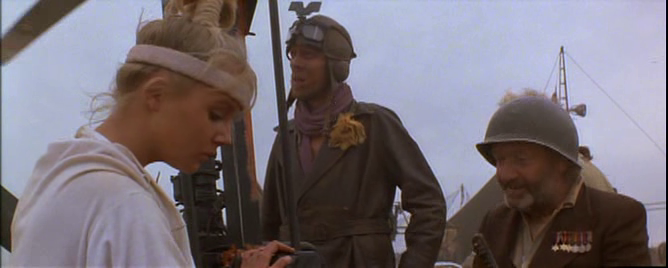
TheFilmist: One of the things Miller always seems to come back to is tribes in a wasteland of some kind, whether it be physical (The Road Warrior, Beyond Thunderdome, and Happy Feet) or moral (Babe: Pig In the City), and this ties in to the next visual motif that I'd like to touch on: one of the recurring shots I've found in all of his work is the usually-ultimately-benevolent tyrant character, situated above everyone else, looking down from a sort of perch.
Sven: Of all the Miller films I know, Thunderdome is definitely the one I know best.
TheFilmist: There's Aunty Entity, situated above the public in her beehive - Thelonious, in Babe: Pig In the City (as well as Rex, the first time we see him in the first film), and the also obvious Noah the Elder, from Happy Feet.
Sven: Yeah, I would extend that to the Peter Ustinov character in Lorenzo's Oil as well. And while I can't recall any shots looking up at him, he definitely winds up more benevolent than malicious I think, which is one of Miller's great triumphs in that film. Great connection, though.
TheFilmist: Oh, yes. You could also extend that to Pappagallo, although I don't know if I'd place him in the same role as Aunty Entity or Thelonious.
Sven: Well, they're all figures that are set up to be the primary antagonists, set up to work against the goals of their respective films' heroes. And are then set aside for more pressing and realistic hurdles.
TheFilmist: Ultimately, they're all - if not necessarily sympathetic then empathetic characters, especially in the case of Aunty Entity and Peter Ustinov's character.
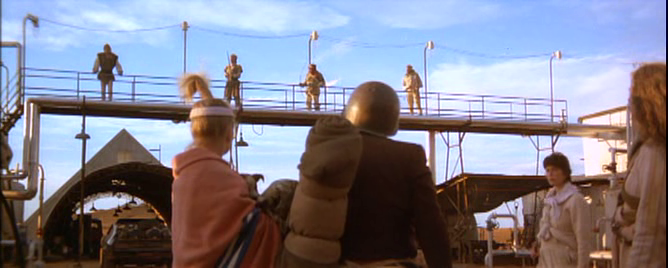
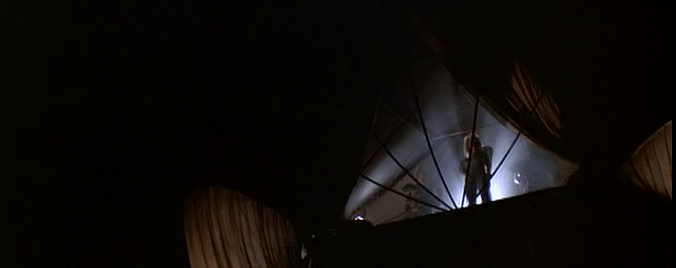

TheFilmist: Another thing Miller's come back to in four of his films (Beyond Thunderdome, Witches of Eastwick, Lorenzo's Oil, and Happy Feet) is spirituality.
Sven: Interesting. As a secular humanist, I tend to avoid spiritual readings of movies. I'm interest to hear what you have to say. It's pretty self-evident in Happy Feet and kind of in the Witches of Eastwick. And I remember that heart-wrenching shot of the crippled dog briefly frolicking in the afterlife in Babe: Pig in the City.
TheFilmist: Well, in all four of those, it's overt. Thunderdome sees the children developing a primitive religion based on their collective pasts, and Lorenzo's Oil there's a crisis of faith experienced by Susan Sarandon's character. Oh, and that too. That's a good catch. Two of these really seem to approach it with something of an anthropological approach in mind - that is, "Thunderdome" and "Happy Feet," but especially the former. "Happy Feet" is actually kind of interesting, because of how well-thought out the whole penguin culture seems, in the context of their surroundings. It's completely allegorical, don't get me wrong. But, it does so in a way that isn't too much of a stretch - it's very primitive, but also very mythological - just like what we saw of the rabbits' culture in Watership Down. But, Thunderdome is interesting because of the way it shows how cultural symbols are reused and imbued different meaning - the "River of Light," that one kid with the Bugs-Bunny doll, and so on - as well as how we use myth, through the microcosm of the children.
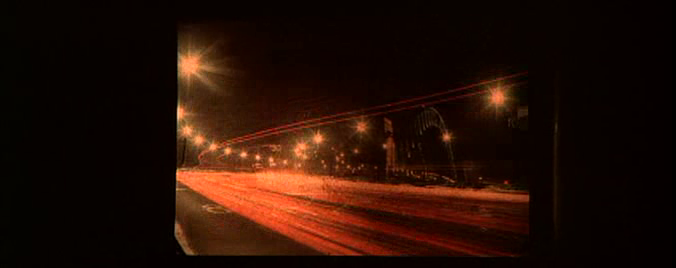
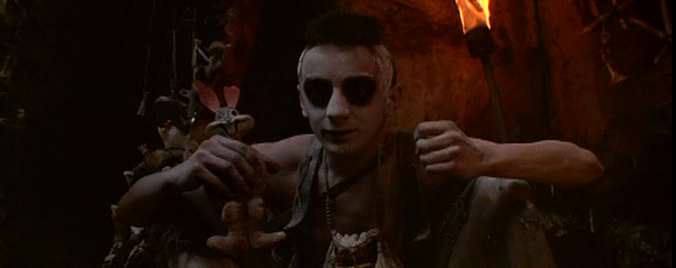
Sven: I always thought that kid with the Bugs doll was a little strange. It definitely felt right in the spirit of the series's theme of reappropriating remnants of a lost civilization and melding them into our own sense of the world. ie, look at the way our current civilization view things like the pyramids or Stonehenge.
And in light of that understanding, it was always uncanny to see the children looking towards Mel Gibson for enlightenment. Because really... he's Mel Gibson. And there's little more mythological than movie stars and little more microcosmic than the fame, prestige, or simple exposure that is thrust upon them by masses looking for direction.
TheFilmist: Especially in the case of Mel Gibson, at that point in time.
Sven: Precisely.
TheFilmist: Speaking of Mel Gibson, I took a look at his cinematic - thing, "Apocalypto," just a little while ago, and it really does seem like it was his attempt to replicate the more outlandish elements of the Mad Max films - and the style and technique of the films, by his own admittance - on foot, but he just can't pull it off. He tries several times to get his gallows humor and the weird, fetishistic violence to run together, but it just comes off as awkward, primarily (I think) because he has the sense of humor of a rock.
Sven: Well, if Braveheart, Man Without a Face, and Passion of the Christ are any indications, I wouldn't say your assessment is far-fetched, though nothing would've been more welcome in Passion than a car chase. That movie was the definition of dismal.
TheFilmist: I'll never understand the point of that movie.
(we then diverged to talk about Jesus films for just a little bit, but then -)
TheFilmist: But, back on topic - it's a very cargo cult-esque culture, with the children. What most people don't seem to notice is the visual aesthetic inherent in there. They're essentially Aborigines.
Sven: I can't help but notice that we've barely spoke of his Twilight Zone sequence, which may, depending on the day, be my favorite thing that Miller has ever done.
TheFilmist: Oh, yes.
Sven: It helps that I'm a massive Lithgow fan, of course. As any sane person is. And this is as much a tour-de-force of his own as much as it is an exciting and awe-inspiring use of the camera in such a confined space.
TheFilmist: Lithgow certainly deserves a lot more recognition. It's eerie how smoothly he can shift between roles - just before this, he was the firey minister in "Footloose," and the killer in De Palma's "Blow Out."
Sven: His role in De Palma's Raising Cain might be my favorite screen performance. Ever.
TheFilmist: Ah, yes.
Sven: And really, when you get right down to my entire take on cinematic art, craft, talent, etc., it amounts to an appreciation of the ensemble orchestration of the piece and the dynamics of the relation between on-screen action and camera manipulation. I don't, in the end, think political, artistic, or philosophical complexity makes a film great. Case in point: the Lithgow short with the gremlin. We all know it, it is part of our cultural consciousness, we know how it ends and we know what it means. But by gum, Lithgow and Miller sell that damn thing. Composition, rhythm, and movement, and a wonderful, wonderful performance.
TheFilmist: I love how everything ostensibly normal is pushed into the abstract - the leering, rhythmic faces that kind of remind me a little of what Gilliam did a lot in "Fear and Loathing," the exaggerated use of confined spaces like the bathroom, and so on.
Sven: Yes. I found it more Jacob's Ladder than Fear and Loathing, but I see your point.
TheFilmist: "I'll remember your face."

Sven: Anyway, I think that's about all I can do, Mr. Filmist.
TheFilmist: Well, there is one other thing I'd like to touch on, before we settle off for the night.
Sven: Certainly.
TheFilmist: And it's less about a subtext that's actually present than one that seems misdirected - of a homophobic slant in the two earlier Mad Max films. This has always been a little strange to me, primarily because we see about four or five women in the group of marauders, and the film even takes a little ocker comedy with the top of the tent being ripped off of the two lovers.
Sven: I cannot say that I've ever seen any homophobia in the Mad Max films... if anything, its near entirety of male bodies suggests to me that brand of man love made so popular by action films of the 80s, where men don't need women to get by.
TheFilmist: Interesting.
Sven: And lest we forget the obvious homosexuality subtexts of Happy Feet, which speak of a very politically progressive filmmaker.
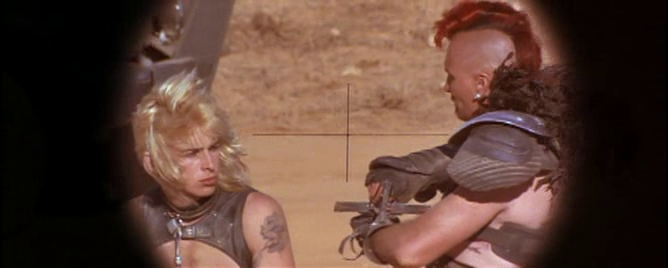
TheFilmist: Well, that's one of the more popular interpretations that keeps popping up everywhere. Makes sense, I suppose. Also, I'd read a little while back on that board we both frequent that you'd written a paper on "Beyond Thunderdome." Do you still have that anywhere? I think it'd provide a marvelous cap-off for this whole thing.
Sven: I could email it to you, but I don't know if it would be all that fitting because it's not an analysis or anything.
TheFilmist: Oh, please do.
Sven: I'm speaking of it in the context of Hollywood filmmaking and the tension created between that and its Australian identity. It's on its way.
No comments:
Post a Comment